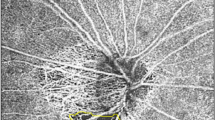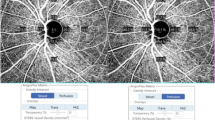Abstract
Purpose
To investigate the factors associated with the development of glaucoma in the healthy eyes of unilateral glaucoma patients.
Materials and methods
This was a retrospective observational case series study. All participants had unilateral primary open-angle glaucoma at the initial visit and were divided into two groups: one in which the fellow eyes developed glaucoma during the follow-up period and one in which the fellow eyes remained healthy. A complete ophthalmic examination, including best-corrected visual acuity testing, slit-lamp examination, intraocular pressure measurement, retinal nerve fiber layer and optic disk photographs, a 30-2 visual field test, and optical coherence tomography with angiography, was performed over a follow-up period of at least 3 years.
Results
A total of fifty-six patients were enrolled, and over the course of the study period, 11 patients developed glaucoma in the fellow eyes, while the fellow eyes of 45 patients remained healthy. At the baseline, the glaucomatous eye had a larger area of beta parapapillary atrophy, lower parapapillary choroidal vascular density (pCVD) within the area, and a lower prevalence of microvascular dropout than normal fellow eyes (P < 0.001, 0.013, 0.001, respectively). In the multivariate analysis, a reduced pCVD in the gamma parapapillary atrophy (γPPA) region was significantly associated with the development of glaucoma in normal eyes (odds ratio, 0.566; 95% CI, 0.342, 0.935; P = 0.026).
Conclusions
The pCVD within the γPPA region at baseline is the risk factor for the development of glaucoma in the normal fellow eye of patients with unilateral glaucoma.





Similar content being viewed by others
Data availability
The datasets generated during the present study are available from the corresponding author on reasonable request.
References
Kim YW, Lee EJ, Kim TW et al (2014) Microstructure of β-zone parapapillary atrophy and rate of retinal nerve fiber layer thinning in primary open-angle glaucoma. Ophthalmology 121:1341–1349. https://doi.org/10.1016/j.ophtha.2014.01.008
Yamada H, Akagi T, Nakanishi H et al (2016) Microstructure of peripapillary atrophy and subsequent visual field progression in treated primary open-angle glaucoma. Ophthalmology 123:542–551. https://doi.org/10.1016/j.ophtha.2015.10.061
Akagi T, Iida Y, Nakanishi H et al (2016) Microvascular density in glaucomatous eyes with hemifield visual field defects: an optical coherence tomography angiography study. Am J Ophthalmol 168:237–249. https://doi.org/10.1016/j.ajo.2016.06.009
Vianna JR, Malik R, Danthurebandara VM et al (2016) Beta and gamma peripapillary atrophy in myopic eyes with and without glaucoma. Investig Ophthalmol Vis Sci 57:3103–3111. https://doi.org/10.1167/iovs.16-19646
Penteado RC, Zangwill LM, Daga FB et al (2018) Optical coherence tomography angiography macular vascular density measurements and the central 10–2 visual field in glaucoma. J Glaucoma 27:481–489. https://doi.org/10.1097/IJG.0000000000000964
Lee J, Kook MS, Choi J et al (2017) Regional vascular density–visual field sensitivity relationship in glaucoma according to disease severity. Br J Ophthalmol 101:1666–1672. https://doi.org/10.1136/bjophthalmol-2017-310180
Lee EJ, Lee KM, Lee SH et al (2016) Oct angiography of the peripapillary retina in primary open-angle glaucoma. Investig Ophthalmol Vis Sci 57:6265–6270. https://doi.org/10.1167/iovs.16-20287
Na HM, Lee EJ, Lee SH et al (2020) Evaluation of peripapillary choroidal microvasculature to detect glaucomatous damage in eyes with high myopia. J Glaucoma 29:39–45
Kim JA, Lee EJ, Kim TW (2019) Evaluation of parapapillary choroidal microvasculature dropout and progressive retinal nerve fiber layer thinning in patients with glaucoma. JAMA Ophthalmol 137:810–816
Kass MA, Kolker AE, Becker B (1976) Prognostic factors in glaucomatous visual field loss. Arch Ophthalmol 94:1274–1276
Chen PP, Park RJ (2000) Visual field progression in patients with initially unilateral visual field loss from chronic open-angle glaucoma. Ophthalmology 107:1688–1692
Susanna R, Drance SM, Douglas GR (1978) The visual prognosis of the fellow eye in uniocular chronic open-angle glaucoma. Br J Ophthalmol 62:327–329
Yarmohammadi A, Zangwill LM, Manalastas PIC et al (2018) Peripapillary and macular vessel density in patients with primary open-angle glaucoma and unilateral visual field loss. Ophthalmology 125:578–587
Anderson DR, Braverman S (1976) Reevaluation of the optic disk vasculature. Am J Ophthalmol 82:165–174
Onda E, Cioffi GA, Bacon DR et al (1995) Microvasculature of the human optic nerve. Am J Ophthalmol 120:92–102
Yin ZQ, Millar TJ et al (1997) Widespread choroidal insufficiency in primary open-angle glaucoma. J Glaucoma 6:23–32
Jonas JB, Nguyen XN, Naumann GO (1989) Parapapillary retinal vessel diameter in normal and glaucoma eyes. I. Morphometric data. Invest Ophthalmol Vis Sci 30:1599–1603
Jonas JB (2005) Clinical implications of peripapillary atrophy in glaucoma. Curr Opin Ophthalmol 16:84–88
Lee EJ, Lee SH, Kim JA et al (2017) Parapapillary deep-layer microvasculature dropout in glaucoma: topographic association with glaucomatous damage. Invest Ophthalmol Vis Sci 58:3004–3010
Lee EJ, Kim TW, Lee SH et al (2017) Underlying microstructure of parapapillary deep-layer capillary dropout identified by optical coherence tomography angiography. Invest Ophthalmol Vis Sci 58:1621–1627
Jonas JB, Martus P, Horn FK et al (2004) Predictive factors of the optic nerve head for development or progression of glaucomatous visual field loss. Invest Ophthalmol Vis Sci 45:2613–2618
Teng CC, De Moraes CG, Prata TS et al (2010) Beta-zone parapapillary atrophy and the velocity of glaucoma progression. Ophthalmology 117:909–915
Dai Y, Jonas JB, Huang H et al (2013) Microstructure of parapapillary atrophy: beta zone and gamma zone. Invest Ophthalmol Vis Sci 54:2013–2018
Park HY, Shin DY, Jeon SJ et al (2019) Association between parapapillary choroidal vessel density measured with optical coherence tomography angiography and future visual field progression in patients with glaucoma. JAMA Ophthalmol 137:681–688
Hu X, Shang K, Chen X et al (2021) Clinical features of microvasculature in subzones of parapapillary atrophy in myopic eyes: an OCT-angiography study. Eye 35:455–463
Park HL, Kim JW, Park CK (2018) Choroidal microvasculature dropout is associated with progressive retinal nerve fiber layer thinning in glaucoma with disc hemorrhage. Ophthalmology 125:1003–1013
Suh MH, Park JW, Kim HR (2018) Association between the deep-layer microvasculature dropout and the visual field damage in glaucoma. J Glaucoma 27:543–551
Lee EJ, Kim TW, Kim JA et al (2018) Central visual field damage and parapapillary choroidal microvasculature dropout in primary open-angle glaucoma. Ophthalmology 125:588–596
Jo YH, Shin JW, Song MK et al (2020) Choroidal microvasculature dropout is associated with generalized choroidal vessel loss within the β-parapapillary atrophy in glaucoma. Am J Ophthalmol 215:37–48
Jonas JB, Jonas SB, Jonas RA et al (2012) Parapapillary atrophy: histological gamma zone and delta zone. PLoS ONE 7:1–7
Chen PP (2002) Correlation of visual field progression between eyes in patients with open-angle glaucoma. Ophthalmology 109:2093–2099
Ha A, Kim YW, Lee J et al (2021) Morphological characteristics of parapapillary atrophy and subsequent visual field progression in primary open-angle glaucoma. Br J Ophthalmol 105:361–366. https://doi.org/10.1136/bjophthalmol-2019-315477
Acknowledgements
None.
Funding
No funds, grants, or other support was received.
Author information
Authors and Affiliations
Contributions
SK contributed to the design of the study, revising the article, and approving the version to be published. JHS contributed to the conception of the study, acquisition and interpretation of data and approving the version to be published. KP contributed to performing the statistical analysis and drafting the article. JS contributed to the design of the study, acquisition and interpretation of data, drafting the article, and approving the version to be published.
Corresponding author
Ethics declarations
Conflict of interest
The authors declare that they have no conflict of interest.
Ethics approval
This study was approved by Institutional Review Board of Pusan National University Yangsan Hospital, South Korea.
Additional information
Publisher's Note
Springer Nature remains neutral with regard to jurisdictional claims in published maps and institutional affiliations.
Rights and permissions
About this article
Cite this article
Kim, S., Seo, J.H., Park, K. et al. The choroidal microvasculature of the parapapillary area as a biomarker of glaucoma development in the fellow eye of patients with unilateral glaucoma. Int Ophthalmol 43, 313–324 (2023). https://doi.org/10.1007/s10792-022-02430-2
Received:
Accepted:
Published:
Issue Date:
DOI: https://doi.org/10.1007/s10792-022-02430-2




